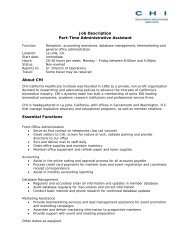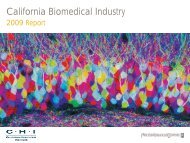California Biomedical Industry - California Healthcare Institute
California Biomedical Industry - California Healthcare Institute
California Biomedical Industry - California Healthcare Institute
You also want an ePaper? Increase the reach of your titles
YUMPU automatically turns print PDFs into web optimized ePapers that Google loves.
Stem cell research innovation: Scientific breakthroughs coming one after anotherReverting adult cells to anembryonic-like stateWhile other researchers were focusedon triggering embryonic stem cells tobecome specific replacement tissues,Shinya Yamanaka M.D., Ph.D., figuredout a way to reprogram adult skin cells tobecome embryonic-like stem cells.Yamanaka’s discovery of inducedpluripotent stem cells (iPS cells)circumvents two disadvantages ofembryonic stem cells. Using iPS cellsharms no embryos and, because theycan be derived from the patient’s owntissues, iPS cells should not pose a riskof immune rejection when transplantedinto the patient’s body. In addition,iPS cells are an effective research toolfor modeling drugs, screening drugcompounds and testing for side effectsor toxicity. One day, iPS cell-derivedfunctional cells may serve as the sourcefor cell transplantation therapies.In addition to his primary lab at KyotoUniversity in Japan, Yamanaka is asenior investigator at UC San Francisco’sGladstone <strong>Institute</strong> of CardiovascularDisease, where he was a postdoctoralfellow in the 1990s. He also is a professorof anatomy at UCSF. Although Yamanakais not personally supported by CIRMfunding, the Gladstone <strong>Institute</strong> does haveshared lab space supported by CIRM forcarrying out stem cell research.Yamanaka, who in June 2010 received the$610,000 Kyoto Prize for his stem cell work,continues to study iPS cells and ways toimprove the safety and predictability of theprocess for making them.Fighting leukemia and otherblood disordersOne type of human stem celldifferentiates to become either red orwhite blood cells. In a small subset ofthe population, however, the cells areable to bypass the regulation process.Consequently, the bone marrowproduces excessive numbers of redblood cells, leading to problems withblood clotting, heart attacks and, in somecases, leukemia. More than 100,000Americans have been diagnosed with theresulting class of blood diseases calledmyeloproliferative disorders (MPD).Catriona H.M. Jamieson, M.D., Ph.D.,and her research team used humancord blood stem cells to show that themutation in the JAK2 signaling pathwaywas responsible for overproduction ofred blood cells. In 2006, Jamieson, whois an assistant professor of medicine atthe University of <strong>California</strong>, San Diegoand Director for Stem Cell Research atMoores UCSD Cancer Center, identifiedan inhibitor that can stop the overproliferationof blood cells in people withMPD. The work was funded in part by aCIRM grant.Acting on Jamieson’s findings, San Diegopharmaceutical company TargeGendeveloped a selective JAK2 inhibitorcalled TG101348. This therapy wasshown in animal studies to halt overexpressionof the gene and reverseexcessive production of red blood cells.The company completed a multi-centerPhase I clinical trial of its oral compoundin October 2009 in patients withmyelofibrosis. Although TargeGen hassince been acquired by Sanofi-Aventis,Phase II trials had been expected tobegin in late 2010.Jamieson’s stem cell research continues.In October 2010, she received a $3.34million CIRM grant toward her work ontargeting stem cells in leukemia patientsthat can evade chemotherapy treatmentand turn into malignant cells after a periodof remission. That follows a $20 millionCIRM grant that she and a UCSD colleaguereceived in October 2009 to develop newdrugs to fight leukemia stem cells.Seeking a treatment for Lou Gehrig’sdiseaseStem cell-based therapies carry specialpromise for the more confoundinghuman diseases and disorders. Amongthese conditions is Amyotrophic LateralSclerosis (ALS), also known as LouGehrig’s Disease. ALS is a progressiveneurodegenerative disease that affectsnerve cells in the brain and the spinalcord. When motor neurons die, the abilityof the brain to initiate and control musclemovement is lost. The progressivedegeneration of motor neurons in ALSeventually leads to paralysis and death.There is currently no cure for ALS, andtreatments currently are aimed at slowingthe progression of the disease andmaking patients more comfortable astheir symptoms worsen. A collaborativeteam of San Diego researchers is workingto change that for the estimated 30,000Americans living with the disease.Sam Pfaff, Ph.D., a professor in theSalk’s Gene Expression Laboratory andan investigator for the Howard HughesMedical <strong>Institute</strong>, is leading the group ofresearchers that also includes co-principalinvestigators Larry Goldstein, Ph.D., andDon Cleveland, Ph.D., both of UCSD.The team is focused on astrocytes,star-shaped support cells that providenutrients for nearby motor neurons.Working with six different lines of humanembryonic stem cells (hESC), theteam will grow clinical-grade astrocyteprecursor cells and identify the line that isbest suited for implantation in laboratorymodels. They hypothesize that thetransplanted human astrocyte precursors(hAP) will mature into astrocytes in vivoand provide support for diseased spinalmotor neurons. Astrocytes are alsocapable of clearing excess neurotoxicglutamate and could thereby slow or haltthe progression of ALS by preventingmotor neuron degeneration.Once the astrocyte precursors are testedfor efficacy and safety to minimize thepossibility of tumorigenesis, the next stepwill be to seek FDA approval to moveforward with human clinical trials.The work is being funded by an $11.5million, four-year CIRM Disease TeamAward that was awarded in October2009. The grants, in a $200 million roundof financing, were designed explicitly toresult in FDA approval for clinical trials.96 | <strong>California</strong> <strong>Biomedical</strong> <strong>Industry</strong> 2011 Report






